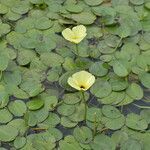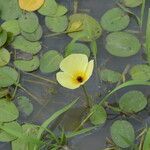Herbs to 50 cm tall; stolons to 45 cm long. Petiole 1.5-40 cm long, ca. 1 cm wide, sheathing base to 8.5 cm long; blade broadly ovate to orbicular, 1.4-11.9 x 0.9-10.6 cm, apex obtuse to slightly mucronate, base cordate, primary veins 5-9. Inflorescence with 1-6 flowers, proliferating with leaves and stolons; peduncle to 30 cm long, 1.5-6 mm diam.; bracts elliptic, 2-4.5 x 0.4-1 cm, apex obtuse; pedicels spreading, 3.5-17.5 cm long, 1.5-6 mm diam. Flowers ca. 6.5 cm wide; sepals 1.3-2.8 x 0.7-1.3 cm, apex obtuse, without midvein; petals pale yellow to white with yellow base, spreading, longer than sepals, 2.3-2.6 x 3.8-4.1 cm; stamens 20-25, in 2 or more series, filaments 5-5.5 mm long, anthers 5.5-6 x ca. 0.5 mm, staminodia numerous; carpels 5-8, ca. 1 cm long. Fruit 1-1.5 x 0.2-0.35 cm, with 0.35-0.55 cm long beak; seeds ca. 1 mm long, sparsely glandular pubescent, glandular trichomes ca. 0.15 mm long, 150-200 μ apart, not present on every epidermal cell of seed coat.
"Stoloniferous" perennial, tufts bright green. Stems semi-transparent, with internal septa. Leaves in tufts, floating on surface or projecting above surface, laminae to 7 × 6 cm, ovate, or orbicular-cordate, thick, shining, midrib swollen towards base on underside, 3 less prominent lateral nerves on either side all converging at leaf-tip; petiole very long, ± transparent, with internal septa. Flower solitary, yellow, conspicuous, slightly above water level; peduncle terete with basal membranous bract; sepals 1.5-2 cm long, narrow-ovate, green, shining, spongy, margins incurved, tip obtuse; petals c. 5 × 4 cm, broadly obovate, clear yellow, deeper yellow towards base, very fragile and ephemeral, ± lobed at tip. Stamens numerous, conspicuous, c. 1 cm long, in whorls from a spongy disc round carpels, inner stamens with sulphur-yellow anthers c. 5 mm long, outer sterile with reddish-purple filaments only. Follicles not seen.


